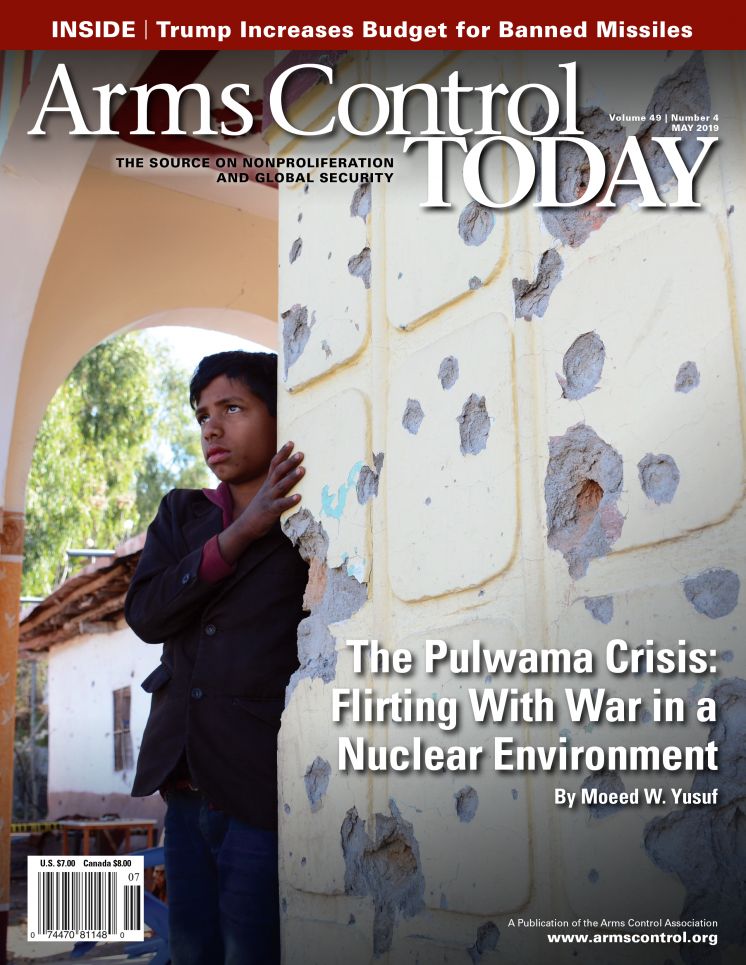Arms Control Today, News in Brief, May 2019
The publication of the News in Brief section of Arms Control Today magazine is a joint project of the Center for International Security and Policy and The Arms Control Association.
Russia Challenges Changes to CWC
Russia officially objected on April 10 to the Canadian-Dutch-U.S. proposal to add Novichok-related chemicals to the list of banned chemicals in the Chemical Weapons Convention (CWC), forcing a vote on the proposal at the next meeting of all treaty parties in November.
The proposal was “clearly substandard from a scientific point of view,” Russia said in a Foreign Ministry statement on April 12, calling one of the chemicals in the proposal “theoretical.”
The Russian objection was a “cynical attempt to undermine the effectiveness of [the] OPCW after [a] shocking attack in Salisbury,” said Peter Wilson, UK ambassador to the Netherlands, in an April 10 tweet. “Canada is very alarmed by this Russian obstruction,” read an April 11 statement from the Canadian Foreign Ministry.
Russia submitted its own proposal to add different sets of Novichok-related chemicals to the CWC, but the Russian proposal was voted down in February in an Executive Council meeting after a technical evaluation. The Russian Foreign Ministry statement suggested considering the rejected Russian proposal together “as a package” with the Canadian-Dutch-U.S. proposal when states-parties vote later this year.
If any change to the list of banned chemicals is adopted in November, this would mark the first change to the treaty’s Schedule 1 list of most dangerous chemicals since the 193-nation pact prohibiting chemical weapons entered into force in 1997.—ALICIA SANDERS-ZAKRE
Switzerland to Decide on Ban Treaty by 2020
The Swiss executive branch decided in April to reconsider joining the Treaty on the Prohibition of Nuclear Weapons (TPNW) five years ahead of schedule in response to a parliamentary motion calling on the government to ratify the treaty by 2020. The Federal Council also cited recent international security developments as an explanation for the expedited review.
Switzerland participated in TPNW negotiations in 2017 and voted in favor of its adoption, but the Federal Council ultimately decided in the summer of 2018 to withhold a Swiss signature or ratification. Switzerland committed to attend the first meeting of TPNW states-parties as an observer and reconsider joining the treaty in 2025.
A Swiss parliamentary motion passed in December last year rejected the Federal Council’s decision and called on the government to join the treaty rapidly, by 2020 at the latest.
The authority of the parliamentary motion over the executive branch is in a “legal grey area,” according to Maya Brehm, the co-founder of the Swiss chapter of the International Campaign to Abolish Nuclear Weapons and a former researcher at the Geneva Academy of International Humanitarian Law and Human Rights. In an April 4 email, she told Arms Control Today that parliamentary motions are binding on the Federal Council and Swiss legal culture respects the authority of the parliament, but the prerogative for signing and ratifying treaties rests with the executive branch.—ALICIA SANDERS-ZAKRE
Trump Orders EMP Readiness Efforts
Warning of the dangers of electromagnetic pulse (EMP) attacks, President Donald Trump signed an executive order on March 26 directing federal agencies to assess and mitigate the risks of an EMP event on the United States. The order, “Coordinating National Resilience to Electromagnetic Pulses,” calls for integrated action by a wide range of federal agencies to address the threat of natural or malicious EMP events.
The concern over EMP attacks was reflected in the Republican platform during the 2016 presidential election campaign: “With North Korea in possession of nuclear missiles and Iran close to having them, an EMP is no longer a theoretical concern — it is a real threat.”
“The executive order sends a clear message to adversaries that the United States takes this threat seriously,” said Energy Secretary Rick Perry in a departmental release supporting the Trump action.
An EMP is a burst of electromagnetic energy that can “disrupt, degrade, and damage technology and critical infrastructure,” according to the executive order. EMP threats can come in two forms: high-altitude nuclear detonations and natural geomagnetic disturbances, such as solar flares.
Critics have long questioned the merits of devoting significant resources to defeating EMP attacks from U.S. adversaries. “Doomsday headlines in the press regarding [North Korea’s] potential EMP threat are grossly overstated,” wrote Jack Liu of 38 North in a 2017 commentary. “EMP is the new test case of seriousness in national security,” said Peter Singer of New America in 2016. “But not in the way advocates not in on the joke think.”—COLE FALKNER
CD Fails to Advance Agenda
The Conference on Disarmament (CD) in Geneva concluded its first session of 2019 in late March without taking forward a program of work. Last year, the CD adopted a proposal to establish subsidiary bodies to advance the body’s work on four core areas: nuclear disarmament, fissile material, outer space, and negative security assurances. (See ACT, April 2018.) Since then, however, it has failed to create the bodies and remained divided on who should lead them.
“The result is that the CD has lost the momentum it began to build up last year,” said Aidan Liddle, the UK permanent representative to the CD, in a March 22 blog post. “A third of the way through the 2019 session, there’s no plan in place for conducting detailed discussions on the core issues,” he added.
The second CD session of 2019 takes place May 13–June 28 in Geneva.—ALICIA SANDERS-ZAKRE

